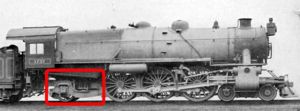Trailing wheel

On a steam locomotive, a trailing wheel or trailing axle is an unpowered wheel or axle located behind the driving wheels. The axle of the trailing wheels were usually located on a trailing truck.
Trailing wheels were used in some early locomotives but fell out of favor for a time during the latter 19th century. As demand for more powerful locomotives increased, trailing wheels began to be used to support the crew cab and rear firebox area. The trailing wheel supported the firebox allowing it to be longer and wider increasing firebox surface area which allowed higher possible boiler pressures which allowed locomotives to produce more power.
In the Whyte notation, trailing wheels are designated by the last numbers in the series. For example, the 2-8-2 Mikado type locomotive had two leading wheels, eight driving wheels, and two trailing wheels. Some locomotives such as the 4-4-0 American type had no trailing wheels and were designated with a zero in the final place.
In the Whyte notation the number designates the number of wheels rather that the number of axles, thus the final 2 in the Mikado's 2-8-2 refers to two wheels (one axle) while the Northern type's 4-8-4 designation refers to four wheels (two axles).
The highest number of trailing wheels on a single locomotive is six as seen on 2-6-6-6 Allegheny type and the Pennsylvania Railroad's 6-8-6 steam turbine and 6-4-4-6 duplex locomotives, as well as numerous Mason Bogie locomotives.
In the UIC classification system, the number of axles rather than the number of wheels is counted.
